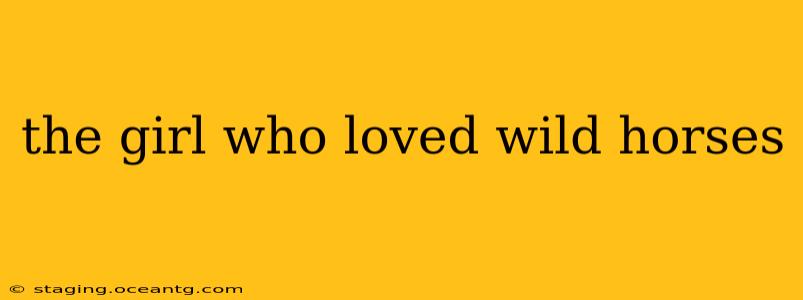The phrase "the girl who loved wild horses" conjures up images of untamed beauty, freedom, and a deep, almost spiritual connection with nature. This isn't just a whimsical notion; it's a reflection of the powerful bond many people feel with these majestic creatures. This article explores the multifaceted relationship between humans and wild horses, delving into the reasons behind this enduring fascination, the conservation challenges facing these animals, and the role we all play in their future.
Why Do People Love Wild Horses So Much?
The allure of wild horses lies in their inherent symbolism of freedom and untamed spirit. They represent a connection to a more primal, natural world, a stark contrast to the often-structured and controlled lives of modern humans. Their beauty, strength, and resilience captivate us, inspiring awe and admiration. But the fascination goes beyond aesthetics. Many find a deep emotional resonance in witnessing their social dynamics, their intricate communication, and their unwavering survival instincts. The wild horse embodies a sense of independence and self-reliance that many find inspiring.
What are the Conservation Challenges Facing Wild Horses?
Wild horse populations face numerous threats, highlighting the urgency of conservation efforts. Habitat loss due to human development and agriculture is a major concern, shrinking their territories and limiting access to crucial resources like water and food. Overgrazing by livestock can further exacerbate this problem, leading to competition for resources and habitat degradation. Disease outbreaks can also devastate populations, especially those already under stress from habitat loss and other pressures. Furthermore, the capture and removal of wild horses for management purposes, often referred to as "roundups," remain controversial and raise ethical concerns among animal welfare advocates.
Are Wild Horses Endangered?
While not all wild horse populations are endangered, many face significant challenges that put their long-term survival at risk. The status of specific herds varies greatly depending on location and management practices. Some populations are thriving, while others are classified as threatened or vulnerable. Continuous monitoring and proactive conservation measures are essential to prevent further decline and ensure the long-term survival of these iconic animals.
What Can We Do to Help Protect Wild Horses?
Protecting wild horses requires a multi-pronged approach involving various stakeholders. Supporting organizations dedicated to wild horse conservation is crucial. These groups often carry out vital research, advocacy, and on-the-ground conservation efforts. Educating ourselves and others about the challenges faced by wild horses is essential for raising awareness and inspiring action. Advocating for responsible land management practices, supporting sustainable agriculture, and promoting policies that prioritize the protection of wild horse habitats are also vital steps. Finally, responsible tourism practices, ensuring minimal disruption to wild horses and their habitats, are essential for protecting these animals.
How Do Wild Horses Communicate?
Wild horses communicate primarily through a complex system of body language, vocalizations, and scent marking. Their postures, facial expressions, and tail movements convey a wide range of information, from social status and mood to warning signs and threats. Vocalizations, such as whinnies, snorts, and nickers, are used for maintaining contact, expressing alarm, or signaling to other members of the herd. Scent marking plays a crucial role in territory defense and social recognition. Understanding these communication methods is essential for anyone involved in wild horse observation or management.
Conclusion: The Enduring Legacy of the Wild Horse
The girl who loved wild horses represents a deep-seated human connection with these remarkable animals. This connection should inspire us to act as responsible stewards of their future. By understanding the challenges they face, supporting conservation efforts, and advocating for responsible management practices, we can ensure that these majestic creatures continue to roam free for generations to come. Their survival is not merely a matter of conservation; it's a testament to our commitment to preserving the beauty and biodiversity of our planet.
